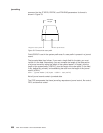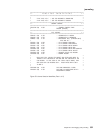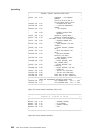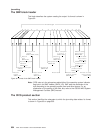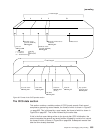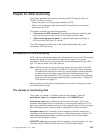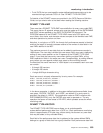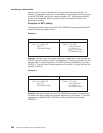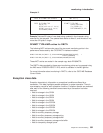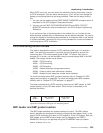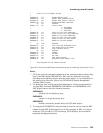You can choose which classes of monitoring data you want to be collected. How to
do this is described in “Controlling CICS monitoring” on page 662.
Performance class monitoring data
CICS performance class monitoring data is collected at system-defined
event-monitoring points (EMPs) in the CICS code. You cannot relocate these
monitoring points, but you can create additional ones, at which user-defined
performance data can be gathered.
Coding additional event-monitoring points
If you want to gather more performance class data than is provided at the
system-defined EMPs, you can code additional EMPs in your application programs.
You could use these additional EMPs to count the number of times a certain event
occurs, or to time the interval between two events, for example. If the performance
class was active when a transaction was started, but was not active when a user
EMP was issued, the operations defined in that user EMP would still be executed
on that transaction’s monitoring area. The DELIVER option would result in a loss of
data at this point, because the generated performance record cannot be output
while the performance class is not active. If the performance class was not active
when a transaction was started, the user EMP would have no effect.
To code user EMPs in your application programs, you use the EXEC CICS
MONITOR command. For programming information about this command, see the
CICS Application Programming Reference
manual.
Additional EMPs are provided in some IBM program products, such as IMS DBCTL.
From a CICS point of view, these are like any other user-defined EMP. EMPs in
user applications and in IBM program products are identified by a decimal number.
The numbers 1 through 199 are available for EMPs in user applications, and the
numbers 200 through 255 are for use in IBM program products. The numbers can
be qualified with an entry name, so that you can use each number more than once.
For example, ‘ENTRYA.4’, ‘ENTRYB.4’, and ‘4’ identify three different EMPs.
Furthermore, any counts, clocks, or byte-strings updated at one of them are
different objects from those updated at any of the others. If you do not specify an
entry name, CICS assumes the default of ‘USER’.
For each EMP that you code in an application program, there must be a
corresponding monitoring control table (MCT) definition, with the same entry name
and identification number as the EMP that it describes. (The following sections refer
to the combination of entry name and identification number as an “empid”.)
If you want to record the same type of data for different transactions, you can code
the same empids in several application programs. This causes similar fields in the
corresponding transaction performance records to be updated.
You do not have to assign empids to system-defined EMPs, and you do not have to
code MCT entries for them.
The monitoring control table (MCT)
You use the monitoring control table (MCT):
v To tell CICS about the EMPs that you have coded in your application programs
and about the data that is to be collected at these points. See “DFHMCT
TYPE=EMP” on page 659.
monitoring—introduction
658
CICS TS for OS/390: CICS Customization Guide



